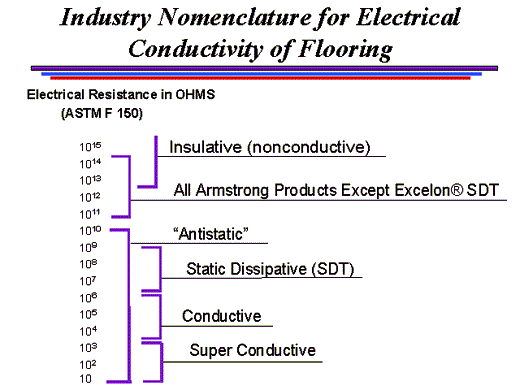
Conductive vs Static Dissipative Flooring
“Conductive” and “static dissipative” are two terms used to define different ranges of electrical resistance measured in ohms.
An ohm is the standard unit of measurement for electrical resistance. It is very small, so the resistance of most ordinary building materials is expressed in a very large number of ohms. For flooring products, the electrical resistance usually falls somewhere between 104 (ten thousand) ohms and 1015 (one quadrillion) ohms. Conductance is the opposite of resistance, so the lower the resistance in ohms, the more a given flooring material will conduct electricity.
As people walk across floors, they typically build up static electricity on their bodies and clothing. The drier the surrounding air, the more charge can be built up. (Water is an excellent conductor of electricity, so the more humid an atmosphere, the more charge will bleed off one’s body onto the water molecules on the floor surface and limit the amount of static buildup.) If people are working with very sensitive electronic equipment, microcircuit assembly in a clean room, explosive gases, or flammable vapor or dust, they need a certain amount of electrostatic control that will conduct electricity off their bodies and take it to ground before it has a chance to destroy the equipment or cause an explosion. One method for helping to remove static electricity from a person’s body is to provide a floor that allows a body charge from shoe soles and heels to dissipate through the flooring material and adhesive to ground. The surface of such a floor provides a path of moderate electrical conductivity between persons and equipment in contact with the floor to prevent accumulation of dangerous electrostatic charges.
Chart #1 shows generally accepted industry terminology for various types of flooring with respect to conductance (or resistance) as tested using a megohmmeter according to the method described in ASTM F 150. Floors with very high electrical resistance (typically well above 1013 ohms) are considered insulative. They often appear in the form of “high dielectric strength” mats that prevent people standing on them from being grounded in areas where exposure to high voltage equipment could be a shock hazard. Most resilient flooring products are not designed to have electrical properties. They fall in the range of 1011 to 1014 ohms resistance and are considered nonconductive under normal use conditions. “Antistatic” is a nonscientific term for floors below 1011 ohms and includes floors described by some guidelines as static dissipative (106 to 109 ohms), conductive (104 to 106 ohms), and super conductive (101 to 104 ohms).
Chart #2 shows some typical use areas for flooring with conductive or static dissipative properties. Most electronic equipment is adequately housed and protected from transmitted static charge. In actual practice, our standard flooring has been used successfully in computer rooms, clean rooms, and laboratories for years without creating static electricity problems. Hospital operating and special procedure rooms in the U.S. no longer use flammable anesthetic gases. Unless there is very sensitive diagnostic instrumentation, it should not be necessary to use static dissipative or conductive flooring.
It is important to follow the end user or equipment manufacturer’s recommendations for specific electrical properties of the floor in a given area. It is also important to follow the flooring manufacturer’s instructions for using the recommended adhesive and installation procedure. And, once the floor has been installed, the flooring manufacturer’s maintenance instructions must be followed. Dirt and other contamination can compromise a floor’s electrical performance. Static dissipative or conductive floor polishes are often required.
Armstrong Flooring Excelon® SDT static dissipative resilient floor tile is currently the only vinyl composition product of its type on the market. Other static dissipative tile, as well as conductive resilient floor tile, is categorized as solid vinyl. (In another Technique Bulletin, we will compare vinyl composition and solid vinyl tile.)
Chart #1

Chart #2
End-Use Areas for Conductive/Static Dissipative Resilient Flooring
Specifically by Electrical Resistivity Range
Super Conductive (1.0 x 10 to 1.0 x 104) – areas with extreme chance of explosion
- Munitions plants and warehouses
- Chemical processing plants and warehouses
- Fireworks production factories and storage areas
Conductive (2.5 x 104 to 1.0 x 106)
- Hospital OR’s still using flammable anesthetics
- Extremely sensitive electronic and computer equipment in manufacturing, assembly and test areas
- Some clean rooms with extremely sensitive equipment
- Extremely sensitive telecommunication installation areas
- Medical diagnostic instrument areas with extremely sensitive instruments
Static Dissipative (1.0 x 106 to 1.0 x 109)
- Electronic and computer equipment in manufacturing, assembly and test areas
- Computer or electronic equipment installation areas
- Clean rooms with sensitive equipment
- Telecommunication installation areas
- Medical diagnostic instrument areas with sensitive instruments
It is important to follow the end user or equipment manufacturer’s recommendations for specific electrical properties of the floor in a given area. It is also important to follow the flooring manufacturer’s instructions for using the recommended adhesive and installation procedure. And, once the floor has been installed, the flooring manufacturer’s maintenance instructions must be followed. Dirt and other contamination can compromise a floor’s electrical performance. Static dissipative or conductive floor polishes are often required.
Armstrong Flooring Excelon® SDT static dissipative resilient floor tile is currently the only vinyl composition product of its type on the market. Other static dissipative tile, as well as conductive resilient floor tile, is categorized as solid vinyl. (In another Technique Bulletin, we will compare vinyl composition and solid vinyl tile.)
